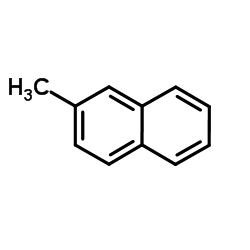2-Methylnaphthalene

2-Methylnaphthalene structure
|
Common Name | 2-Methylnaphthalene | ||
|---|---|---|---|---|
| CAS Number | 91-57-6 | Molecular Weight | 142.197 | |
| Density | 1.0±0.1 g/cm3 | Boiling Point | 239.9±3.0 °C at 760 mmHg | |
| Molecular Formula | C11H10 | Melting Point | 34-36 °C(lit.) | |
| MSDS | Chinese USA | Flash Point | 97.8±0.0 °C | |
| Symbol |



GHS02, GHS06, GHS08 |
Signal Word | Danger | |
|
QSPR modeling of octanol/water partition coefficient for vitamins by optimal descriptors calculated with SMILES.
Eur. J. Med. Chem. 43 , 714-40, (2008) Simplified molecular input line entry system (SMILES) has been utilized in constructing quantitative structure-property relationships (QSPR) for octanol/water partition coefficient of vitamins and organic compounds of different classes by optimal descriptors.... |
|
|
Quantitative structure-activity relationship analysis of inhibitors of the nicotine metabolizing CYP2A6 enzyme.
J. Med. Chem. 48 , 440-9, (2005) The purpose of this study was to develop screening and in silico modeling methods to obtain accurate information on the active center of CYP2A6, a nicotine oxidizing enzyme. The inhibitory potencies of 26 naphthalene and 16 non-naphthalene derivatives were de... |
|
|
Exploring QSAR and QAAR for inhibitors of cytochrome P450 2A6 and 2A5 enzymes using GFA and G/PLS techniques
Eur. J. Med. Chem. 44 , 1941-51, (2009) A series of naphthalene and non-naphthalene derivatives ( n = 42) having cytochrome P450 2A6 and 2A5 inhibitory activities, reported by Rahnasto et al., were subjected to QSAR and QAAR studies. The analyses were performed using electronic, spatial, shape and ... |
|
|
Predictive three-dimensional quantitative structure-activity relationship of cytochrome P450 1A2 inhibitors.
J. Med. Chem. 48 , 3808-15, (2005) The purpose of this study was to determine the cytochrome P450 1A2 (CYP1A2) inhibition potencies of structurally diverse compounds to create a comprehensive three-dimensional quantitative structure-activity relationship (3D-QSAR) model of CYP1A2 inhibitors an... |
|
|
Immunomodulatory effects of dietary exposure to selected polycyclic aromatic hydrocarbons in the bluegill (Lepomis macrochirus).
Int. J. Toxicol. 29(5) , 532-45, (2010) Polycyclic aromatic hydrocarbons (PAH) have been demonstrated to affect immune system modulation. The freshwater species of fish, Lepomis macrochirus (bluegill), was employed to investigate the effects of a 14-day dietary exposure to PAH including 2-aminoanth... |
|
|
Secondary organic aerosol from photooxidation of polycyclic aromatic hydrocarbons.
Environ. Sci. Technol. 44(21) , 8134-9, (2010) Secondary organic aerosol (SOA) formation from the photooxidation of five polycyclic aromatic hydrocarbons (PAHs, naphthalene, 1- and 2-methylnaphthalene, acenaphthylene, and acenaphthene) was investigated in a 9-m(3) chamber in the presence of nitrogen oxide... |
|
|
Metabolism of benzyl alcohol via catechol ortho-pathway in methylnaphthalene-degrading Pseudomonas putida CSV86.
Appl. Microbiol. Biotechnol. 62(5-6) , 579-85, (2003) Pseudomonas putida CSV86 metabolizes 1- and 2-methylnaphthalene through distinct catabolic and detoxification pathways. In spite of the similarity in the steps involved in the methylnaphthalene detoxification and the toluene side-chain hydroxylation pathways,... |
|
|
Thermal growth and decomposition of methylnaphthalenes.
Environ. Sci. Technol. 39(9) , 3077-82, (2005) Diesel particulate matter (DPM) has been recognized as carcinogenic due to its respirable sizes and toxic compositions. It is essential to understand its formation mechanisms to effectively reduce DPM emissions. Studies have indicated that resonance stabilize... |
|
|
Liquid phase separation of polyaromatics on [Cu2(BDC)2(dabco)].
Langmuir 27(15) , 9083-7, (2011) The porous coordination polymer (PCP) [Cu(2)(BDC)(2)(dabco)] is capable of selectively adsorbing up to 25 wt % of either 1-methylnaphthalene or 2-methylnaphthalene. Uptakes of unsubstituted naphthalene and 1,4-dimethylnaphthalene are significantly lower (7-13... |
|
|
Methanogenic biodegradation of two-ringed polycyclic aromatic hydrocarbons.
FEMS Microbiol. Ecol. 81(1) , 124-33, (2012) Polycyclic aromatic hydrocarbons (PAH) are widespread in methane-rich subsurface environments, such as oil reservoirs and fuel-contaminated aquifers; however, little is known about the biodegradation of these compounds under methanogenic conditions. To assess... |